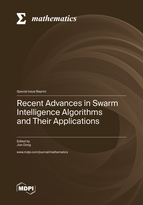Recent Advances in Swarm Intelligence Algorithms and Their Applications
A special issue of Mathematics (ISSN 2227-7390). This special issue belongs to the section "Mathematics and Computer Science".
Deadline for manuscript submissions: closed (31 March 2023) | Viewed by 38359
Special Issue Editor
Interests: swarm intelligence; antenna theory and design; microwave remote sensing; array signal processing
Special Issues, Collections and Topics in MDPI journals
Special Issue Information
Dear Colleagues,
As a branch of artificial intelligence, swarm intelligence refers to the collective behavior of decentralized, self-organized systems. Swarm intelligence is mainly to attract, gather, and manage large-scale participants interacting locally with one another and with their environment. It aims to jointly cope with challenging tasks by means of competition, cooperation, and other independent or collaborative ways, especially the complex system decision-making tasks in the open environment, which leads to the emergence of intelligent global behavior, unknown to individuals.
In recent years, the research community has witnessed an explosion of swarm intelligence algorithms efficiently solving complex computation tasks. This trend has been especially dramatic in what relates to optimization problems, mainly due to the unprecedented complexity of problem instances, arising from a diverse spectrum of domains, such as transportation, logistics, energy, climate, social networks, health and industry 4.0, among many others.
This Special Issue provides a platform for researchers from academia and industry to present their new and unpublished work and to promote future studies in swarm intelligence and its combination with real-world problems and other fields, including but not limited to antenna design, vehicle scheduling, drug design and discovery, image segmentation, feature selection, data clustering, traveling salesman problems, etc.
The second Special Issue volume on this topic has been successfully organized, and the subsequent research can be found at the following link: https://www.mdpi.com/journal/mathematics/special_issues/Y758SX8ZQC.
Prof. Dr. Jian Dong
Guest Editor
Manuscript Submission Information
Manuscripts should be submitted online at www.mdpi.com by registering and logging in to this website. Once you are registered, click here to go to the submission form. Manuscripts can be submitted until the deadline. All submissions that pass pre-check are peer-reviewed. Accepted papers will be published continuously in the journal (as soon as accepted) and will be listed together on the special issue website. Research articles, review articles as well as short communications are invited. For planned papers, a title and short abstract (about 100 words) can be sent to the Editorial Office for announcement on this website.
Submitted manuscripts should not have been published previously, nor be under consideration for publication elsewhere (except conference proceedings papers). All manuscripts are thoroughly refereed through a single-blind peer-review process. A guide for authors and other relevant information for submission of manuscripts is available on the Instructions for Authors page. Mathematics is an international peer-reviewed open access semimonthly journal published by MDPI.
Please visit the Instructions for Authors page before submitting a manuscript. The Article Processing Charge (APC) for publication in this open access journal is 2600 CHF (Swiss Francs). Submitted papers should be well formatted and use good English. Authors may use MDPI's English editing service prior to publication or during author revisions.
Keywords
- swarm intelligence
- evolutionary algorithms
- optimization
- metaheuristics
- surrogate modeling
- differential evolution
- real-world applications
- machine learning
- optimal design
- benchmark functions






